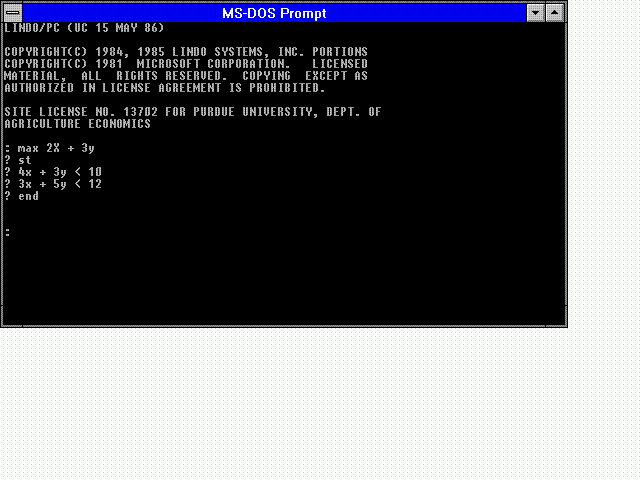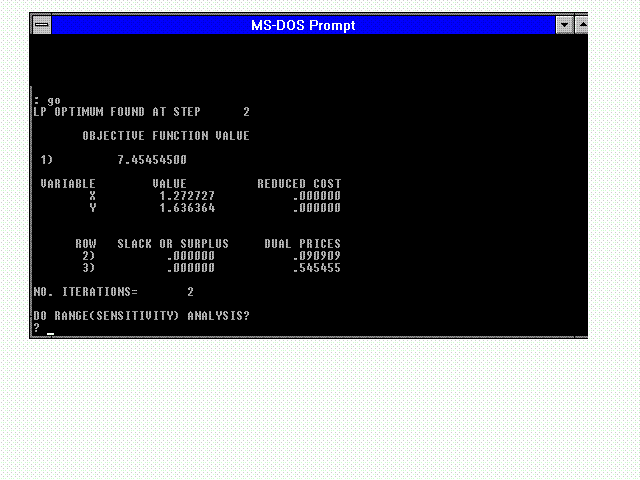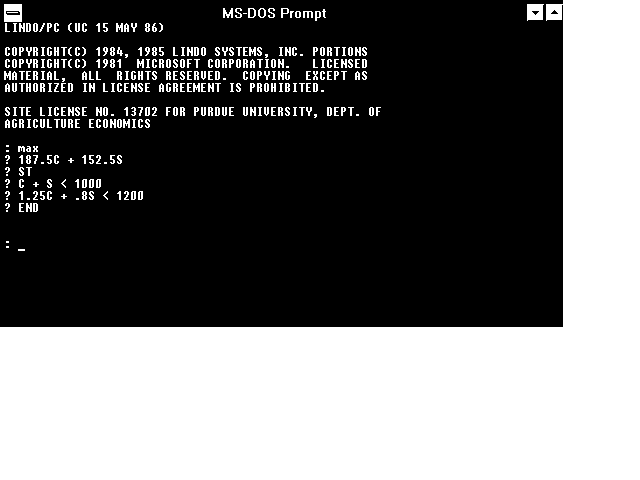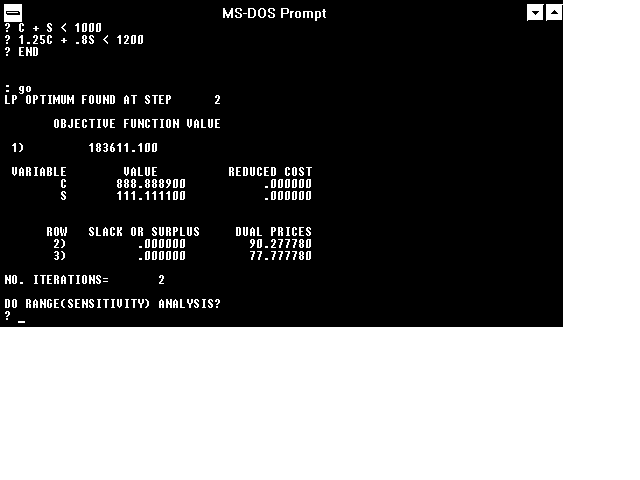Assignment:
Review this document.
Use the LINDO LP solver software to solve the following problems.
Problems are due Friday of week 4 at class time.
45 points
-
The Houses are Us Corporation has acquired 100 lots
on which it is about to build homes near West Lafayatte.
Two styles of homes are to be built, a "Cape Cod" and a "Ranch Home."
Houses are Us wishes to build 100 homes over 9 months
starting in early spring.
During this time, Houses are Us will have 13,000 manhours of bricklayer
labor and 12,000 hours of carpenter labor.
Each Cape Code house requires 200 hours of carpentry labor and 50 hours
of bricklayer labor.
Each Ranch Home requires 120 hours of bricklayer labor and 100 hours
of carpentry.
The profit contribution of a Cape Cod is projected
to be $5,100 and that of each Ranch Home is projected to be $5,000.
- How many of each type of house would you recommend building?
- Houses are Us has an option to by 15 vacant lots adjacent
to their planned development for a total of $60,000.
Should Houses are Us purchase these lots?
- A new salesman for Houses are Us feels certain that she
can sell the Cape Cods for $2,000 more each than the current
projection. If this is the case, should Houses are Us change the
mix of houses that will be built?
-
Ben McDonald operates 3 farms in Texas.
The acreage and irrigation water available for each farm
are shown below.
Farm Acreage Water Available (acre feet)
1 400 1500
2 600 2000
3 300 900
Three crops can be grown; however, the maximum acreage which
can be grown of each crop is limited by the amount
of appropriate harvesting equipment available.
The three crops that can be grown are described below.
Total Harvesting Water Requirements Expected
Crop Capacity (acres) (acre-ft/acre) Profit ($/acre)
Milo 700 6 400
Cotton 800 4 300
Wheat 300 2 100
Any combination of crops may be grown on a farm.
Find the crop mix that will maximize profit.
-
You have just received a contract to produce
animal feed and would like to determine the
least cost combination of materials to produce
the desired product.
The feed must have a minimum of 16% protein and a minimum of 5%
fiber.
You have identified the following as potential ingredients:
ingredient cost ($)/100 kg protein (%) fiber (%)
corn 5.24 8 2
oats 5.71 12 7
corn cob 1.10 10 20
soy meal 8.85 49 3
What is the least cost ration?
What happens if the soybean market is cornered resulting in a doubling
of the price of soy meal?
Important Terms and Concepts:
Introduction to LINDO
LINDO (Linear, INteractive, Discrete Optimizer) is a PC-based tool
for solving linear programming problems. It is a command oriented
program (as opposed to menu oriented). We will be using LINDO
to assist with solving of LP problems in this class.
The commands that will be required
to get started with LINDO are summarized below. LINDO also provides
on-line help that provides further details about these and other commands.
Command Use
MAX Start input of a maximization problem.
MIN Start input of a minimization problem.
ST (Subject To) Start input of constraints.
END End problem input and return to command level.
GO Solve the current problem and print solution.
LOOK Print selected portions of current formulation.
ALTER Alter an element of the current problem.
QUIT Quit LINDO
The following input would be valid input to be entered in LINDO:
MAX 2X + 3Y
ST
4X + 3Y < 10
3X + 5Y < 12
END
The following screens show the above example entered
and solved in LINDO.


Example Application - Optimal Crop Mix
A farmer has 1,000 acres of land and produces corn
and soybeans.
The production of corn requires 1.25 hours of labor per acre
and the production of soybeans requires 0.8 hours per acre.
The farmer obtains average corn yields of 150 bu/acre
and average soybean yields of 45 bu/acre.
Production costs are $150/acre for corn and $95/acre
for soybeans.
For planning purposes, the farmer would like to assume
that the selling price for corn will be $2.25/bu and for soybeans
$5.50/bu.
There are 2 people available 10 hours per day to provide
labor for the 60 day period in which cropping
operations must be completed.
Find the mix of corn and soybean production to maximize profits.
Follow the LP problem solving approach recommended
in the previous course materials to solve the problem.
- Define the control or decision variables.
The control variables in this problem are the areas to be planted
to corn and to soybeans (we'll use the variable
C for corn and S for soybeans).
- Establish the objective function.
The objective in this problem is to maximize profit from the farm.
We can write the profit function (objective function):
Profit= ((2.25)(150)C - 150C) + ((5.50)(45)S - 95S)
-
Establish constraints placed on the system. For our problem,
there are 2 resource constraints - land and labor.
The land constraint is: C + S < = 1000.
The labor constraint is: 1.25C + 0.8S < = 2(10)(60).
Non-negativity of C and S are also assumed.
Next, LINDO was used to solve the above problem.
The resulting screens are shown below.


Note the optimum solution is 888.9 acres of corn and 111.1 acres of soybeans.
Next a sensitivity analysis was requested.
The results are shown in the figure below.

Examining the allowable coefficient ranges for the objective
function before the solution changes, one can determine
the changes in corn and soybean prices and production costs
before the solution changes. Further examination of the
sensitivity results provides information on the
changes in labor and land that would be required before the
solution changes.
Additional LINDO Commands
In the previous section, enough LINDO commands to get one
started in using the software were described.
In this section, additional commands that will likely
be helpful in LP problem solving are described.
Command Use
SAVE Saves the problem formulation in the file specified
DELETE Used to delete a row number (constraint)
EXTEND Used to add more constraints
DIVERT Writes results into the file specified
RVRT Close file to which results were being written
and cause results to be displayed on the screen
RETR Select and load file with problem formulation
HELP Provides on-line help
COMMANDS Lists available commands
LINDO runs on a PC or will run under sunpc from the UNIX workstations
in Agricultural Engineering. I would recommend running from a PC
unless you are familiar with sunpc. You have access to PCs
in the AGAD PC laboratory in the basement of the AGAD building.
You should be able to download LINDO here.
If you have difficulties with the above, try this process.
The following process describes how to install and start LINDO
from a PC in the AGAD lab.
-
Login to the PC and obtain the DOS prompt (the DOS prompt from
MS Windows is acceptable).
-
Use ftp to connect to the ABE file server pasture
by typing the following from the DOS prompt:
ftp pasture.ecn.purdue.edu
-
You will be asked to type your pasture/ecn login
(for example mine is engelb).
-
Next you will be asked to type your pasture password -
note that it will not be displayed when you type it.
-
Next change directories to the location of the LINDO software by:
cd ~engelb/565
-
Set the file type to binary by typing: bin
-
Get LINDO from pasture by typing: get lindo.exe
-
Quit ftp by typing: quit
-
LINDO has now been transferred to the PC at which you are seated.
To start LINDO, type lindo at the DOS prompt.






